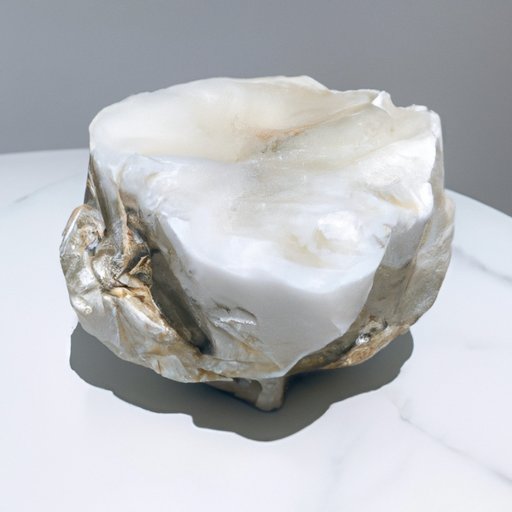Introduction
Alabaster is a beautiful and unique stone that has been prized for its aesthetic and practical properties for centuries. It has been used in art, architecture, and home decor, among other things. In this article, we will explore alabaster in all its glory, from its history and science, to its use in art and home decor, and its cultural significance around the world.
Exploring the Beauty and History of Alabaster: A Beginner’s Guide
Alabaster is a fine-grained, translucent stone that is composed of gypsum or calcium sulfate. It is found in many parts of the world and has been used since ancient times for ornamental and practical purposes. Alabaster was particularly popular in Egypt, where it was used to create beautiful and intricate sculptures and sarcophagi.
Today, alabaster is still highly valued for its unique aesthetic and practical properties. It is used to create a wide range of decorative and functional items, including vases, bowls, lamps, and more. Some people also use alabaster as a decorative element in their homes, such as in the form of wall panels or tile.
One of the key reasons why alabaster is so popular is its unique beauty. It has a striking, translucent appearance that gives it a delicate and ethereal quality. Additionally, alabaster can be polished to a high shine and is available in a wide range of colors and patterns.
The Science behind Alabaster: How It Gets Its Unique Properties
Alabaster is formed when gypsum or calcium sulfate deposits are dissolved and then recrystallized over time. This process creates a fine-grained, translucent stone that is relatively soft and easy to carve. Alabaster is found in many parts of the world, including Egypt, Italy, Spain, and the United States.
The unique properties of alabaster are due in part to its composition. Alabaster is composed of calcium sulfate, which is a soft mineral that allows it to be easily shaped and crafted. Additionally, alabaster is known for its translucent and delicate appearance, which is due to the crystal structure of the stone. Light passes through alabaster in a unique way, producing a soft, diffused glow that is unlike any other stone.
The Curious Art of Alabaster Carving: An In-Depth Look
Alabaster carving is a delicate and intricate art that requires a great deal of skill and patience. The process of carving alabaster involves removing small pieces of the stone using a variety of tools, including chisels, hammers, and saws. Artists use different techniques and approaches to create beautiful and intricate sculptures, vases, and other decorative items.
Some of the most famous and beautiful alabaster sculptures from history include the Tomb of Pope Alexander VII, the Alabaster Cenotaph of Seti I in Egypt, and the Alabaster Mosque in Cairo. These sculptures showcase the intricate beauty and unique properties of alabaster, and continue to inspire and delight people around the world.
Decorating with Alabaster: Top Tips and Ideas
If you’re interested in incorporating alabaster into your home decor, there are many different ways to do so. One of the most popular ways to use alabaster is to create lamps, which can produce a soft, diffused glow that is perfect for creating a cozy and inviting atmosphere. Alabaster vases and bowls can also be used to add a touch of elegance and sophistication to any room.
Alabaster can be used in many different design styles, from modern to traditional to bohemian. In modern spaces, alabaster can help to create a sleek and minimalist look, while in traditional spaces it can add a touch of classic elegance. In bohemian spaces, alabaster can be mixed and matched with other textures and patterns to create a unique and eclectic look.
Alabaster Around the World: A Cultural Tour
Alabaster has played a significant role in many different cultures around the world. In ancient Egypt, alabaster was used to create beautiful sculptures and sarcophagi, while in ancient Rome it was used for architectural details and ornamental objects. In Spain, alabaster is used to create a variety of handicrafts, including bowls, vases, and other decorative items.
Religious artifacts made from alabaster are also common in many different cultures, including Christianity, Islam, and Buddhism. For example, in the Middle Ages, alabaster altarpieces were popular in Christian churches, and in Islamic architecture, alabaster is frequently used to create beautiful and intricate patterns and details.
Conclusion
Alabaster is a unique and beautiful stone that has been prized for its aesthetic and practical properties for centuries. Its unique beauty, delicate appearance, and soft texture make it a popular choice for art, architecture, and home decor. Whether you’re interested in exploring alabaster for the first time or you’re already a devoted fan, there is something truly special about this fascinating stone.
